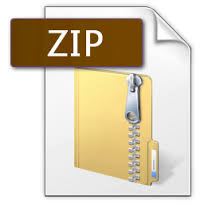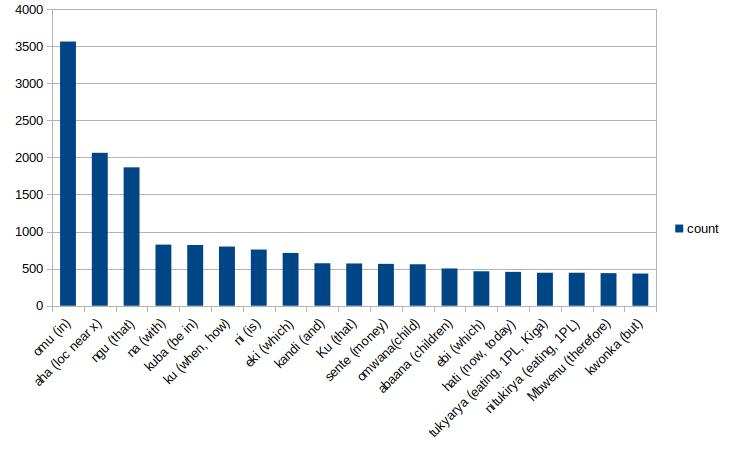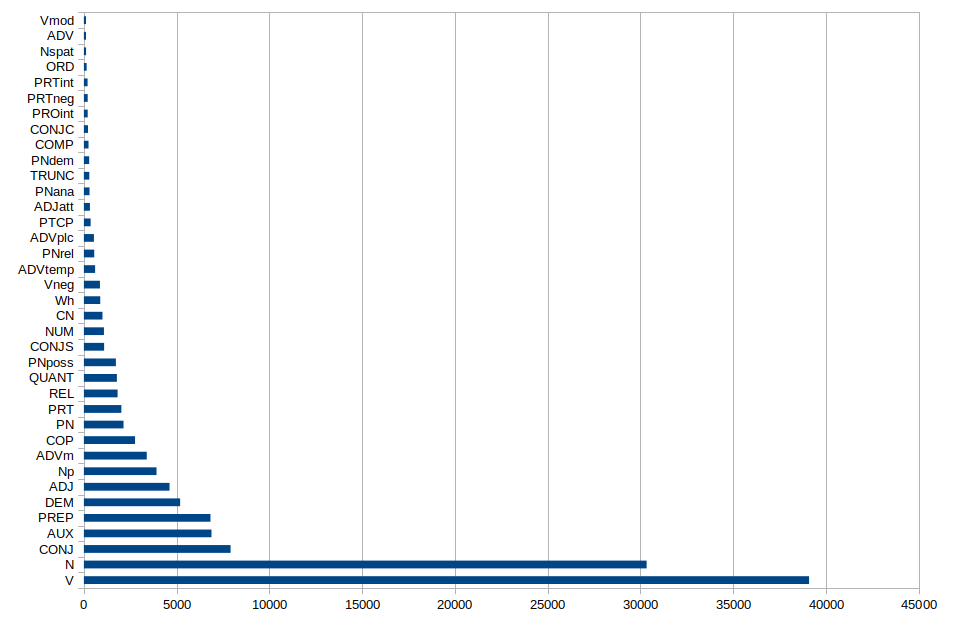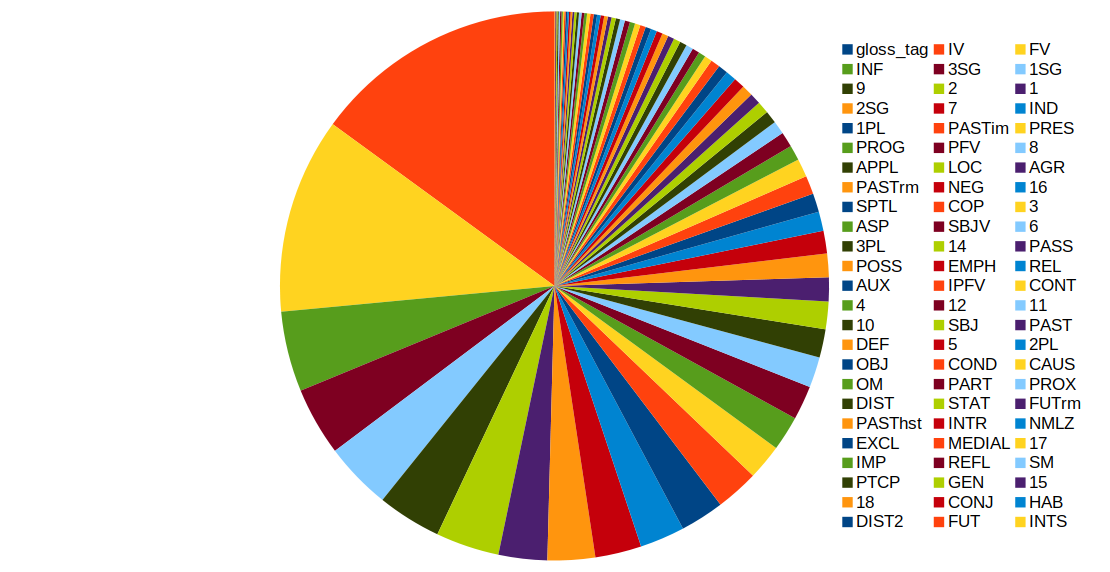Difference between revisions of "Runyankore-Rukiga Corpus"
(→Annotations and Standards) |
|||
| Line 3: | Line 3: | ||
===Purpose of the data collection=== | ===Purpose of the data collection=== | ||
| − | The material available for download from this site is a linguistic data collection for the study of Locative Expressions in Runyankore-Rukiga. It was created using the TypeCraft Runyankore-Rukiga corpus. <ref>TypeCraft allows users to create their own sentence collections from an existing corpus which | + | The material available for download from this site is a linguistic data collection for the study of Locative Expressions in Runyankore-Rukiga. It was created using the TypeCraft Runyankore-Rukiga corpus. <ref>TypeCraft allows users to create their own sentence collections from an existing corpus which makes it possible for them to apply new annotations to already annotated data.</ref>. It was created as a collection of 300 sentences in 2019 by Allen Asiimwe and Dorothee Beermann. Below you find more information about the data collection and the entire TypeCraft Runyankore-Rukiga corpus. |
More about Runyankore and Rukiga: | More about Runyankore and Rukiga: | ||
Revision as of 08:36, 9 January 2020
Contents
Purpose of the data collection
The material available for download from this site is a linguistic data collection for the study of Locative Expressions in Runyankore-Rukiga. It was created using the TypeCraft Runyankore-Rukiga corpus. [1]. It was created as a collection of 300 sentences in 2019 by Allen Asiimwe and Dorothee Beermann. Below you find more information about the data collection and the entire TypeCraft Runyankore-Rukiga corpus.
More about Runyankore and Rukiga:
Runyakitara is standard language based on four closely related languages of western Uganda. These four languages are ((Ru)nyore, (Ru)tooro, (Ru)nyankore, and (Ru)kiga. These languages are spoken in south-western Uganda by approximately 6 million people according to the Uganda National Population and Housing Census report (2014). (Ru)nyankore (ISO 639-3 nyn) and (Ru)kiga (ISO 639-3 cgg ) are spoken in the Ankola and the Kigeza region respectively.
Here we refer to (Ru)nyankore, and (Ru)kiga as Runyankore-Rukiga.
Download
 (The Download is under preparation --Dorothee (talk) 11:14, 8 January 2020 (UTC))
(The Download is under preparation --Dorothee (talk) 11:14, 8 January 2020 (UTC))
The material consists of 298 sentences [ -- packaged -- time stamped ---], which were taken from naturally occurring data (narration, conversations), as well as from prior annotated linguistic sentence collections. The data is provided in the TC-XML format. fro
Description of the of the TypeCraft Runyankore-Rukiga corpus
Creation
The TypeCraft Runyankore-Rukiga corpus of which the data presented here is a part, consists of narratives and short stories, as well as elicited data. Texts are either transcriptions of oral narratives or fragments of newspaper texts from the Runyankore-Rukiga weekly newspaper Orumuri. [2] We also digitised sections taken from the novel Abagyenda Bareeba ‘Adventures of travelers' by Mubangizi (1997) [3]. The data was created by native-speaker linguistics graduates as part of their class work, or in the context of their master’s thesis between 2006 and 2013. The creation process was a collaborative effort coordinated by the principal investigators Dr. Allen Asiimwe (Makerere University, Uganda) and Prof. Dorothee Beermann (NTNU, Trondheim) . The main student contributors were Justus Turamyomwe, Misah Natumanya and Allen Asiimwe. The collection has been extended continuously. For a closer look at the entire corpus please go to the TypeCraft.database. [4].
Size and Format
The TypeCraft Runyankore-Rukiga corpus consists of 143 426 words, corresponding to 28 057 sentences. A table over the most frequent word forms in the corpus shows that the corpus is biased. While it has been created by several users of TypeCraft users working on graduate project addressing different topics the corpus seems to contain more sentences containing locative words than one probably would expect to find in naturally occuring text. Between the 20 most frequent word forms are mostly words belonging to the functional word classes. This is expected.
Table 1. Most frequent 20 words in the TypeCraft Runyankore-Rukiga corpus

Annotations and Standards
We have used two layers of annotation for the labeling of the RR-corpus. Traditionally linguists do not consistently annotate examples for word class, but in the wake of the Digital Humanities leading to a closer cooperation between linguistics and computer scientist, POS-tagged corpora from linguistic work have become more common. Short definitions of the POS symbols can be found here: TypeCraft POS tags
Table 2. Part of Speech tags used for the annotation of Runyankore-Rukiga'

The TypeCraft editor supports the in-depth word-by-word annotation for which TypeCraft provided a list of over 300 glosses. Projects working with TypeCraft can ask for customised glossing lists. For the annotation of Runyankore-Rukiga we worked with TypeCraft's standard Glossing list, using 74 different tags. 13 different noun class tags were used, and the two most frequenctly used glosses are Initial- and Final-Vowel. The legend of the pie chart in Figure 1. lists the Glosses in the order of their frequency from the left to the right, starting from the top.
Short definitions of the Gloss symbols can be found here: TypeCraft GLOSS tags.
Figure 1. Glosses used for the annotation of Runyankore-Rukiga

- ↑ TypeCraft allows users to create their own sentence collections from an existing corpus which makes it possible for them to apply new annotations to already annotated data.
- ↑ Today Orumuri can still be found on Facebook Orumuri, but most of the articles presented are now in English.
- ↑ Mubangizi, B.K.(1997) Abagyenda Bareeba. Memorial Single Volume. Kisubi: Marianum Press.
- ↑ You can search the TypeCraft database from the navigation bar on the left side of your browser window. Select from the TypeCraft Tools menu, Search Texts, then specify the Language, and Press ENTER.